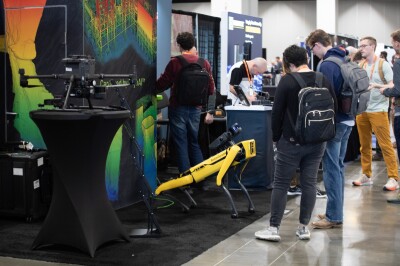In our leadup to Geo Week 2025, held in Denver, Colorado in February, we hosted a “Game Changers Showcase” in which 38 products from the geospatial, 3D, and AEC industries were featured. Every product is still available to view on our Game Changers Gallery, but in addition to hosting the gallery readers and industry professionals were able to make their voices heard to vote for their favorite of the products.
That voting took place prior to the event, and in early February we announced the top five vote-getters in the contest, which included software and hardware for things like layouts, surveying, and BIM modeling. Today, we are taking some time to highlight further the product that was deemed our number one game-changing product by voters: XenomatiX’s XenoBike.
While XenomatiX, based in Belgium, just released the XenoBike last year, they have been providing lidar-based solutions for road inspections for over a decade. Their flagship product, the XenoTrack - which is Class 1 certified in accuracy, repeatability and efficiency for IRI, Rutting and raw profiles (IRI: ASTM 950 – E1926 – AASHTO 56 – Rutting: ASTM E1703 – EN 13036-8) by both NCAT and ICART - can be mounted to the roof of a standard vehicle to collect lidar data while driving through an area. Using high-resolution, short-range, true solid-state lidar, XenoTrack provides accuracy within millimeters and can be used for identifying things like potholes and surface monitoring during construction, among other use cases. There are also options for both single- and dual-lane inspections.

That product does cover the needs of many inspection workflows, but XenomatiX recognized that there were some areas that were not accessible by traditional vehicles, which led to the creation of the XenoBike. An electric vehicle that is roughly the size of a bike and operates like one is made for a similar purpose as the XenoTrack, ultimately designed to inspect pavement. However, whereas the company’s traditional product is for large roadways, the XenoBike allows for inspection of other paved areas, such as bike lanes, sidewalks, and other pedestrian walkways.
Inspecting sidewalks and other pedestrian walkways is not only important to keep an area walkable and active, but also in many parts of the world a requirement by law. In the United States, for example, these areas need to be inspected to stay compliant with the Americans with Disabilities Act, or ADA. Often these inspections, which check for things like the width of an area, slope of a ramp, texture, and hazards like cracks and potholes, can be tedious to do manually. Generally, these areas are too small to fit a typical vehicle-based lidar system, but the XenoBike is designed specifically for these areas.
There are a lot of advantages to using this product as compared to more traditional and manual workflows, including of course the speed. The XenoBike collects data at various speeds and continues to work even with the stopping and starting that will often be necessary for an area populated by pedestrians. It collects data at a width of 86 centimeters and operates on any pavement type, including asphalt, concrete, dirt roads, gravel, bricks, and more. Given the relatively slow speed as compared to a traditional vehicle, operation does not require a driver’s license, and the XenoBike is battery-powered, which enables firms to maintain their ecological goals.
After the collection is completed, users have available to them a bevy of potential insights they can extract from the point cloud data For example, they can derive 3D height maps to get insights via a 3D surface model and color-coded pavement model. They can also produce intensity maps to uncover pavement markings and variations in materials, and 2D color images for visual checks. And, as mentioned above, firms can ultimately identify the location and severity of defects within a walkway, including potholes, cracks, and other obstacles, all of which can be integrated within a project management system or GIS.
All around the world, planners in urban areas are looking for ways to make their communities more accessible and friendly to pedestrians, and that often starts with ensuring existing infrastructure is up to par. That, in turn, requires thorough inspections, and in order to promote consistent use of these areas those inspections must be consistent. That’s where a product like the XenoBike becomes more important, creating an easy and efficient process to complete these inspections with powerful lidar that does not need to be attached to a traditional vehicle.
Clearly, many of our readers agree with the value as well, with the XenoBike being this year’s Game-Changing Product of the Year.
Learn more about the XenoBike here.






